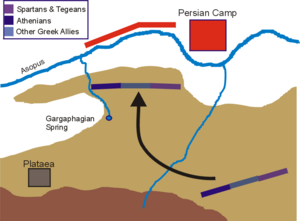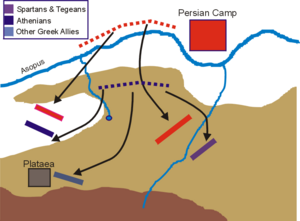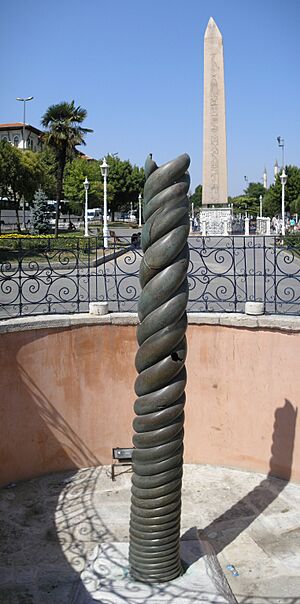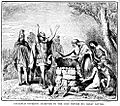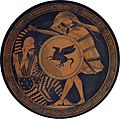Battle of Plataea facts for kids
Quick facts for kids Battle of Plataea |
|||||||||
|---|---|---|---|---|---|---|---|---|---|
| Part of the Greco-Persian Wars | |||||||||
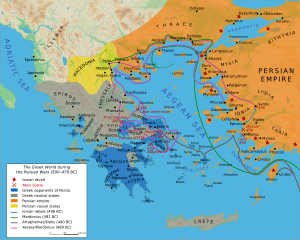 The Greek world at the time of the battle |
|||||||||
|
|||||||||
| Belligerents | |||||||||
| Greek city-states | Achaemenid Empire | ||||||||
| Commanders and leaders | |||||||||
| Pausanias | Mardonius † | ||||||||
| Strength | |||||||||
| 110,000 (Herodotus) 100,000 (Pompeius) ~40,000 (Modern consensus) |
300,000 (Herodotus) 70,000–120,000 (Modern consensus, including Greek allies) |
||||||||
| Casualties and losses | |||||||||
| 10,000+ (Ephorus and Diodorus) 1,360 (Plutarch) 159 (Herodotus) |
257,000 (Herodotus) | ||||||||
The Battle of Plataea was a very important land battle. It was the final big fight during the second Persian invasion of Greece. This battle happened in 479 BC near the city of Plataea in Boeotia.
It was a huge win for the Greeks. This victory finally ended the war. The battle was fought between the Greek allies and the Persian Empire. The Greek allies included powerful city-states like Sparta, Athens, Corinth, and Megara. The Persian army was led by Xerxes I's general, Mardonius.
Contents
Why the Battle Happened
The Persian Invasion of Greece
The year before Plataea, the Persian army, led by King Xerxes himself, invaded Greece. They won battles at Thermopylae and Artemisium. This allowed them to take control of areas like Thessaly, Boeotia, and Attica.
However, the Greek navy fought back. They won a surprise victory at the naval Battle of Salamis. This stopped the Persians from conquering the entire Peloponnesus. After this defeat, King Xerxes went back home. He left his general, Mardonius, in charge. Mardonius was ordered to finish conquering the Greeks the next year.
The Armies Gather
Greek and Persian Forces
In the summer of 479 BC, the Greeks put together a very large army. It was one of the biggest armies they had ever assembled. This army marched out of the Peloponnesus.
The Persians, led by Mardonius, moved back to Boeotia. They built a strong camp near Plataea. The Greeks did not want to fight on the open ground near the Persian camp. This area was good for the Persian cavalry (horse soldiers). Because neither side wanted to attack, there was a standoff for eleven days.
The Battle Begins
A Tricky Retreat
The Greek army's supplies started to run low. They decided to move back a bit to get better supplies. This movement caused their battle lines to break apart. General Mardonius saw this and thought the Greeks were running away.
He quickly ordered his Persian soldiers to chase after them. But the Greeks were not retreating completely. They turned around and fought back. The main Greek forces, especially the Spartans, Tegeans, and Athenians, fought bravely.
The Greek Victory
The Greek soldiers were well-armed and trained. They defeated the lightly armed Persian infantry. During the intense fighting, the Persian general Mardonius was killed.
Many Persian soldiers were trapped in their camp. The Greeks then attacked the camp and defeated them. This huge victory at Plataea, along with another Greek naval victory at the Battle of Mycale (which happened on the same day), ended the Persian invasion.
After Plataea and Mycale, the Greeks started to attack the Persians. This began a new part of the Greco-Persian Wars. Even though Plataea was a very important win, it was not as famous as the Athenian victory at the Battle of Marathon. It was also less famous than the brave Greek defeat at Thermopylae.
Remembering the Battle
Monuments to the Heroes
A special bronze column was made from melted-down Persian weapons. It was shaped like intertwined snakes and is called the Serpent Column. This column was put up at Delphi.
It honored all the Greek city-states that fought in the battle. Their names were listed on the column. Most of this column still exists today. You can find it in the Hippodrome of Constantinople (which is now Istanbul). It was moved there by Constantine the Great when he founded his city.
Images for kids
-
Aristides tells Mardonius's messengers that the Greeks will never make peace with Xerxes.
-
Aristides, the commander of the Athenians, gets information from Alexander I of Macedon. Alexander, an ally of the Persians, tells him that delaying the fight would hurt the Persians' supplies.
-
A scene from the Battle of Plataea on the south frieze of the Temple of Athena Nike in Athens. The right side might show the fight over Masistius's body.
-
A Greek hoplite and a Persian warrior fighting, shown on an ancient kylix (drinking cup) from the 5th century BC.
-
A coin of Alexander I of Macedon from the time after the Battle of Plataea (480/79-470 BC).
See also
 In Spanish: Batalla de Platea para niños
In Spanish: Batalla de Platea para niños


